Cite this document
(“The Concrete Era of Boston City Research Paper Example | Topics and Well Written Essays - 1250 words”, n.d.)
The Concrete Era of Boston City Research Paper Example | Topics and Well Written Essays - 1250 words. Retrieved from https://studentshare.org/music/1459955-the-concrete-era-of-boston-city
The Concrete Era of Boston City Research Paper Example | Topics and Well Written Essays - 1250 words. Retrieved from https://studentshare.org/music/1459955-the-concrete-era-of-boston-city
(The Concrete Era of Boston City Research Paper Example | Topics and Well Written Essays - 1250 Words)
The Concrete Era of Boston City Research Paper Example | Topics and Well Written Essays - 1250 Words. https://studentshare.org/music/1459955-the-concrete-era-of-boston-city.
The Concrete Era of Boston City Research Paper Example | Topics and Well Written Essays - 1250 Words. https://studentshare.org/music/1459955-the-concrete-era-of-boston-city.
“The Concrete Era of Boston City Research Paper Example | Topics and Well Written Essays - 1250 Words”, n.d. https://studentshare.org/music/1459955-the-concrete-era-of-boston-city.


